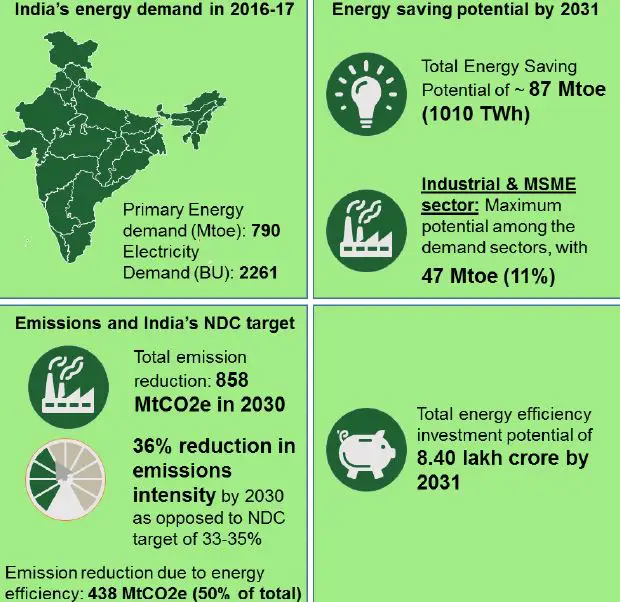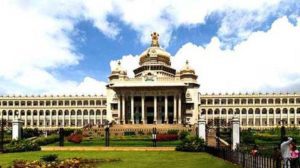Unlocking National Energy Efficiency Potential (unnatee) | UPSC – IAS
Bureau of Energy Efficiency (BEE) has developed a national strategy document titled UNNATEE (Unlocking NATional Energy Efficiency Potential) towards developing an energy efficient nation (2017-2031).
- It describes a plain framework and implementation strategy to establish a clear linkage between energy supply-demand scenarios and energy efficiency opportunities. The document offers a comprehensive roadmap to address India’s environmental and climate change mitigation action through energy efficiency measures.
- This exercise is first of its kind, clearly delineating the energy efficiency targets for the respective demand sectors upto the state levels. Developing India’s blueprint of effective energy efficiency strategy is a leap towards stimulating energy efficiency ecosystem and enabling reduction of the pressure on demand
Why India need UNNATEE ? | UPSC – IAS
- In India, there is still an immense potential to be realized from large scale implementation of energy efficiency interventions in the various demand sectors like industry, agriculture, transport, municipal, domestic and commercial lighting and appliances and Micro, small and medium scale enterprises (MSME).
- In this context, BEE, with support from PricewaterhouseCoopers Private Limited has developed the national strategic plan for energy efficiency, presented in the form of this report “Unlocking National Energy Efficiency Potential – UNNATEE, Strategy plan towards developing an energy efficient nation (2017-2031)”.
Background Knowledge
- India is expected to grow at around 8% and almost every economic activity requires energy. If energy consumption (primary energy and electricity) in India were to continue along current lines, it could lead to a growing imbalance between supply and demand.
- The gap between supply and demand can be fulfilled by either increasing generation or by enhancing the efficiency of energy usage.
Some key numbers can be seen as-
- India’s energy demand in 2016-17= 790 Mtoe(million tonnes of oil equivalent)
- Energy saving potential by 2031= 87 Mtoe
- Total emission reduction= 858 MtCO2 in 2030
- Total energy efficiency investment potential= Rs. 8.40 lakh crore by 2031
UNNATEE Implementation Strategy | UPSC – IAS
Favourable Regulations | UPSC – IAS
Through an overarching energy efficiency policy, which includes targets, incentives and penalties.
- Agriculture- Inclusion of agro projects under the National Clean Energy Fund
- Buildings- Introduction of incentives for purchasing energy efficient houses.
- Industry- Increasing the scope of the PAT programme.
- Transport- Roll out of the proposed FAME-II scheme.
Institutional Framework | UPSC – IAS
through strong enforcement mechanism at state levels, which would lend further strength to the national and local level program.
- Agriculture– A single window system for export of products and services will improve the competitiveness of sector R&D.
- Buildings- A reporting framework for where the states are required to update their progress in implementation of Energy Conservation Building Code in their state.
- Industry- Creation of an energy management cell.
Availability of Finance | UPSC – IAS
In the form of a revolving fund, risk guarantee, On-bill financing, Energy Savings Insurance, Energy Conservation Bonds.
- Agriculture- Reduce interests in priority sector lending.
- Buildings- Targeting low LCOC rather than low initial building cost by building for affordable maintenance.
- Industry- Creation of fund for R&D in industry with 1% of turnover.
- Transport- Introduction of ToD tariff rates for EVs. E.g. Telangana State Electricity Regulatory Commission has fixed the tariff for charging stations at Rs. 6 per unit.
Use of technology | UPSC – IAS
- Including Internet of Things and Blockchain have the ability to bring an energy revolution across sectors. Example in agriculture (smart control panels), municipal (CCMS), commercial (building management systems), domestic (electric cook stoves).
Stakeholder Engagement | UPSC – IAS
- Would result in faster adoption and smoother implementation. E.g. for adoption of electric vehicles it is important to first have policies for promotion and adoption of EVs, institutional framework to train new breed of engineers to make the transition to EVs, ecosystem players to provide services like EV charging and consumers to buy the vehicles.
- Data Collection- Setting up of a Nodal Agency that advocates data collection and dissemination, covering the entire energy value chain of the country.
- Setting State wise targets- Mandatory reporting of sector wise energy consumption, status of all EE programmes and the target of the same and energy efficiency roadmap.
- Center of Excellence for industries- to increase R&D in specific sectors.





